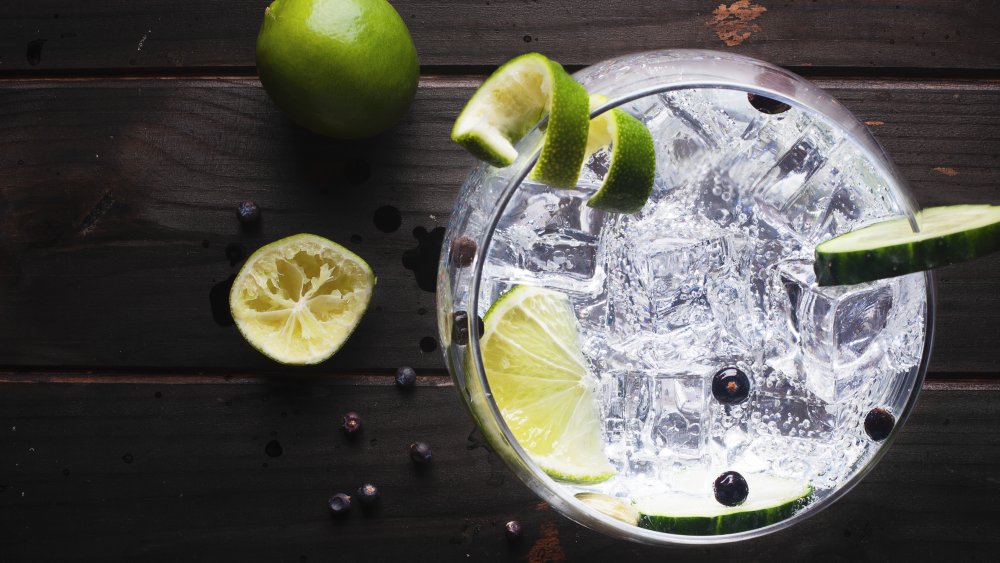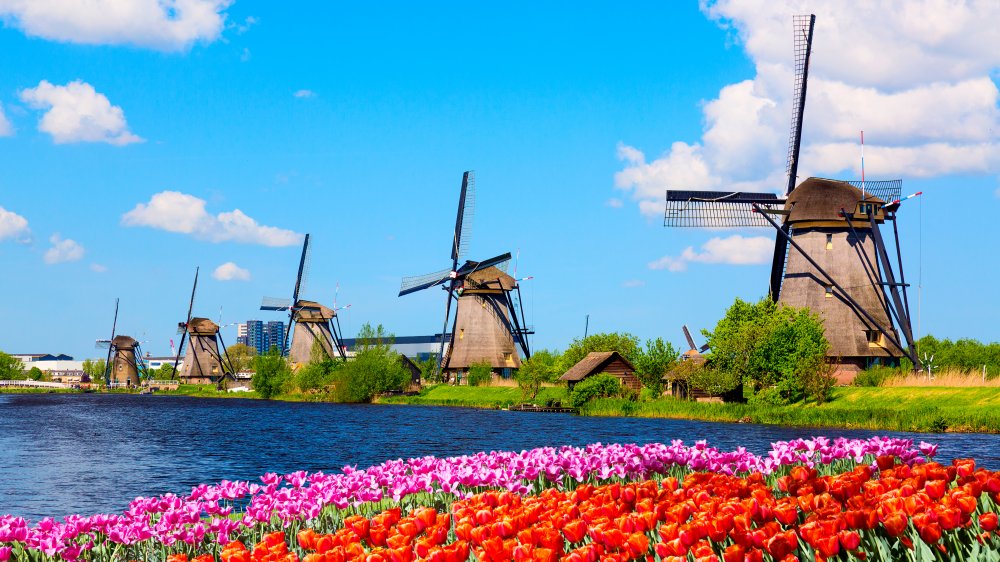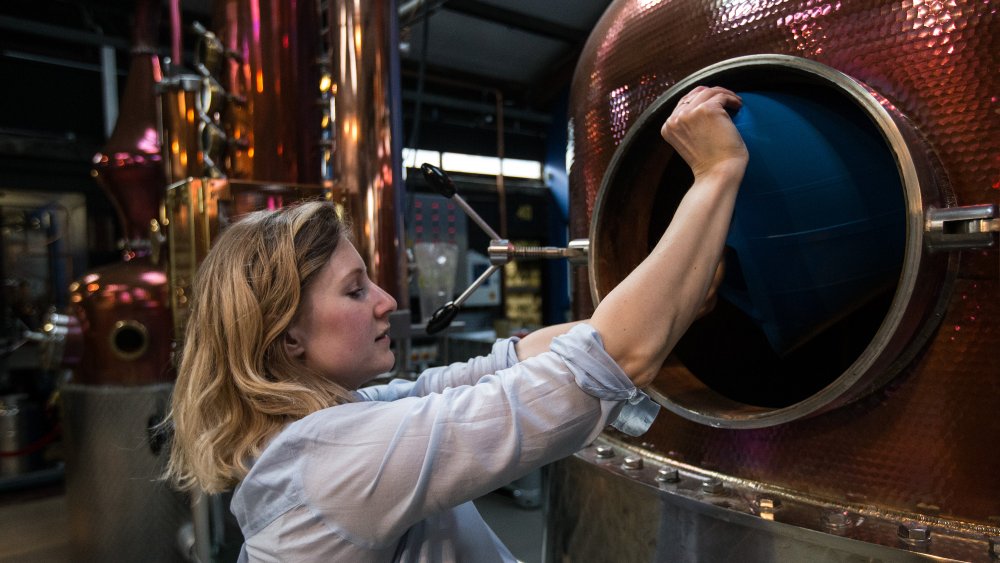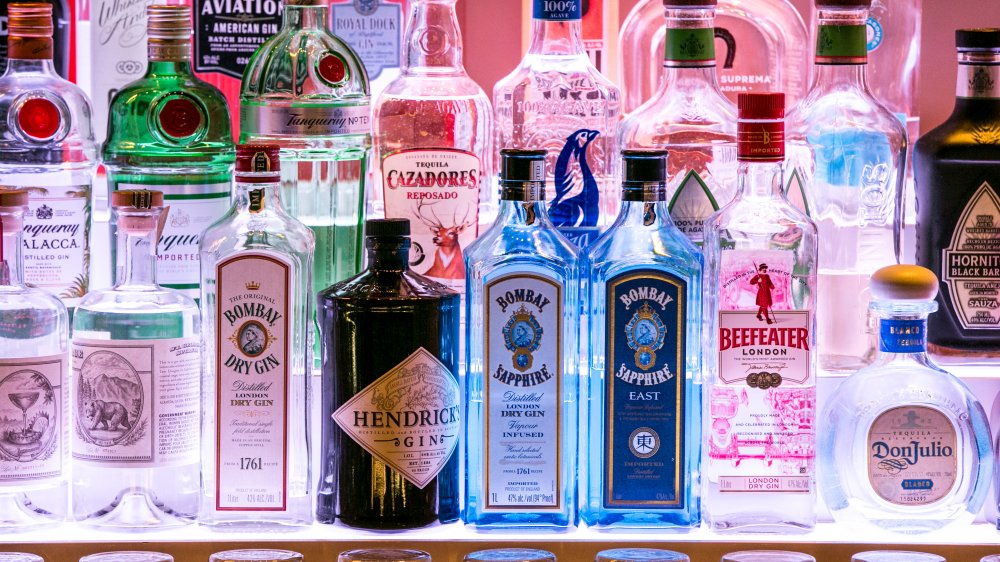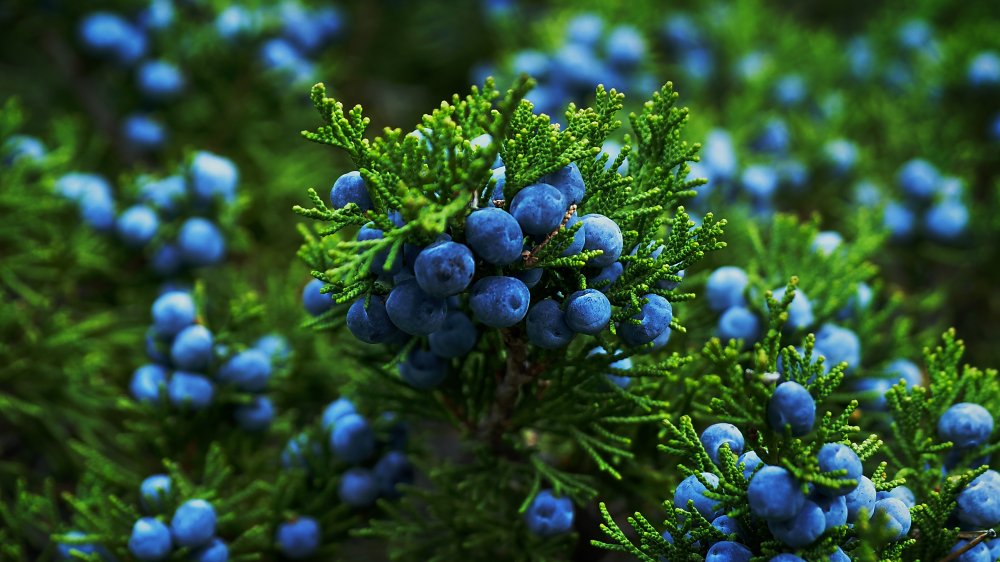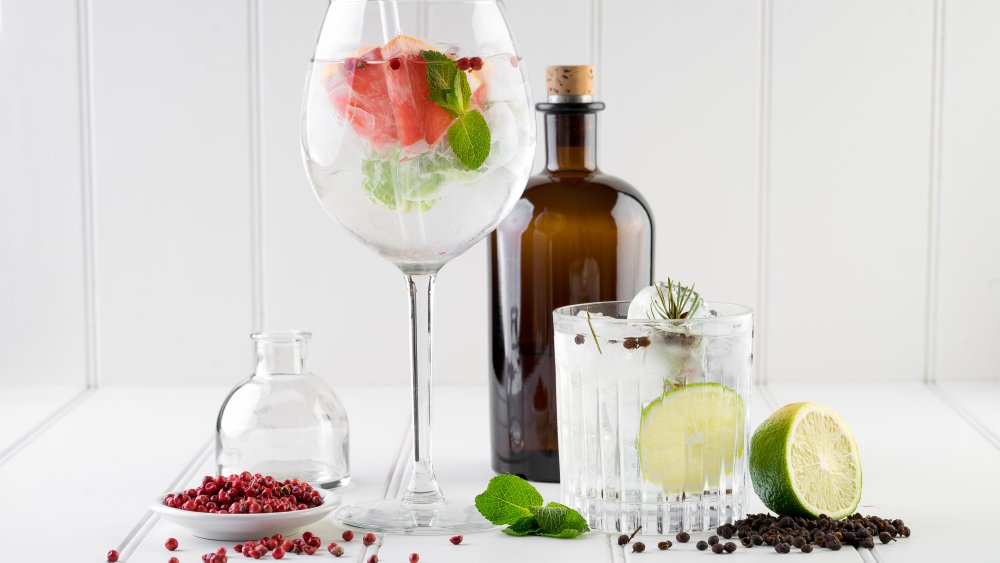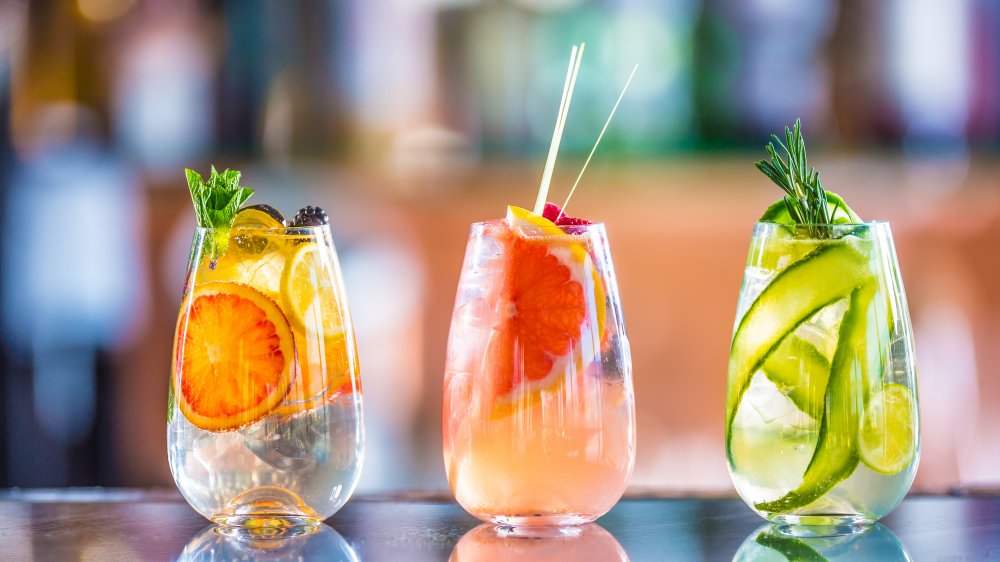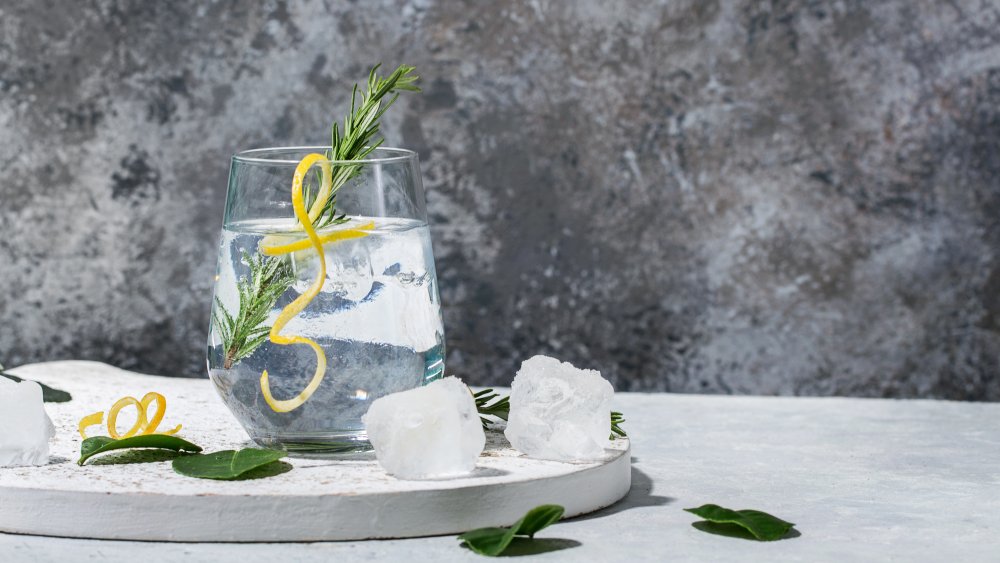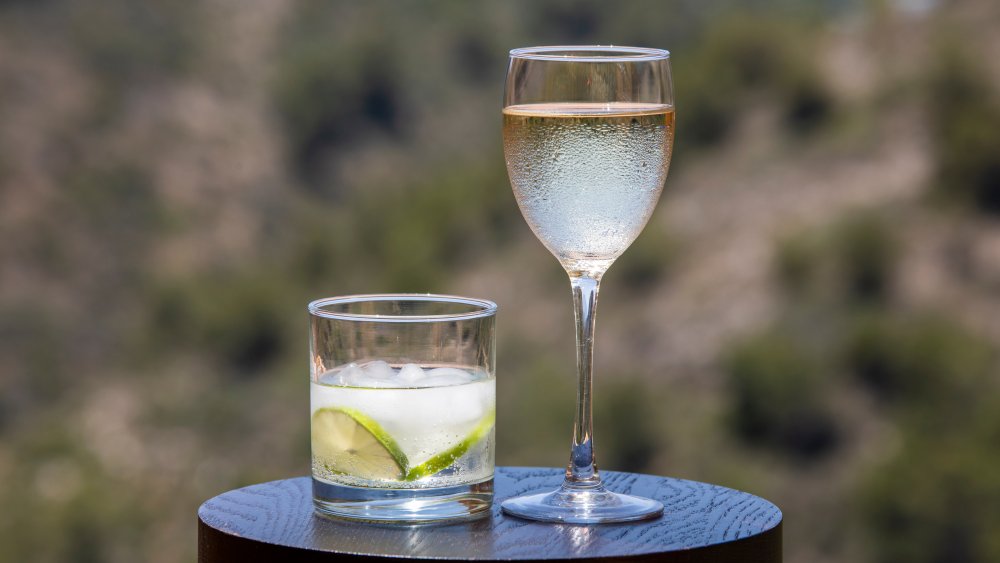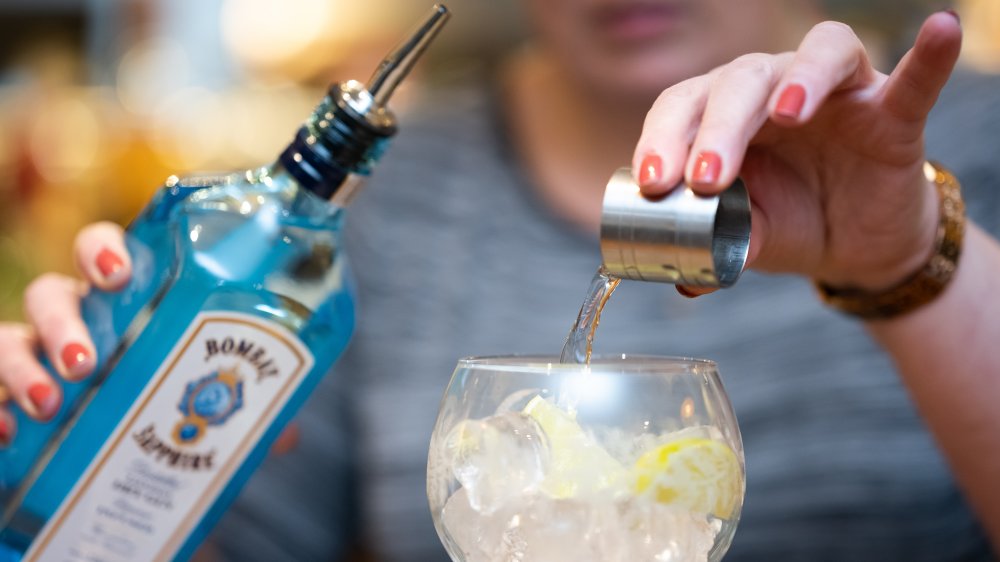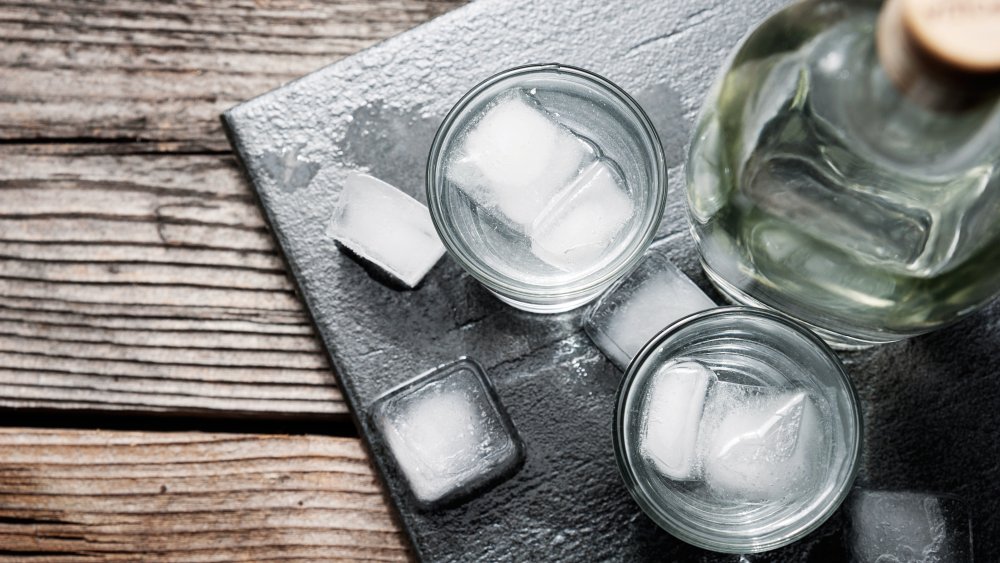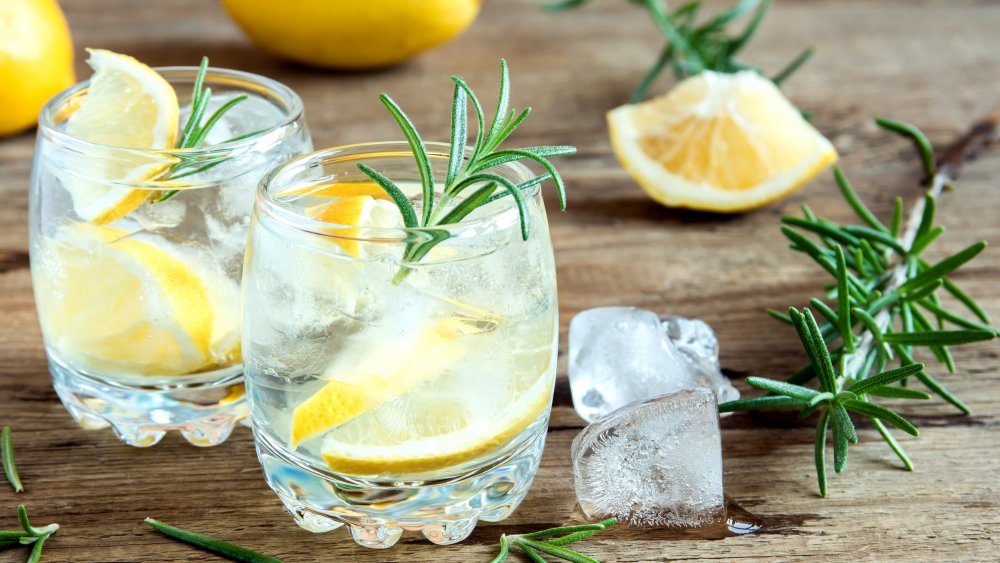What You Should Know Before Taking Another Sip Of Gin
There are two categories of people when it comes to drinking gin. There's those who enjoy sipping on their nightly gin and tonic, enjoying the unique floral and herbaceous flavors of the liquor, expertly paired with a mixer. And then there's those who have only had gin at a party mixed with juice, thanks to Snoop Dogg's song Gin and Juice, and woke up the next morning with a pounding headache. Certainly, there are parties in between, with love/hate relationships with the spirit, but one thing we can all agree on is that the flavors of gin are incredibly complex.
Because of those complex flavors, gin has sometimes gotten a bad rap, as it hasn't always been as popular as other clear liquors such as vodka and white rum. But, it has recently had a spike in popularity as more craft distillers are marketing specialty products, and many more consumers are learning to embrace its unique qualities.
But what exactly are the requirements to call a liquor gin? And what's the fascinating history behind its uses? We decided to dig in to take a closer look. Here's what you need to know before taking another sip of gin.
Gin was invented in Holland
If you've only recently been introduced to gin, it's probably because there's been a huge spike in gin sales (a whopping 267 percent) as the craft distilling movement has been playing with new and unique liquor options. But gin is a tale as old as time.
Genever is the Dutch word for juniper, which is where gin gets its name. There are references to genever dating back to the 13th century and the ways it was used for flavoring spirits. But when the 1600s came around, there were countless distilleries in Holland producing gin, especially in Amsterdam. At the time, it was mainly produced for medicinal purposes, and the popularity caught on exponentially during the Thirty Years' War. The British discovered the unique botanical spirit at that time, and in the early 18th century, people in London went a little crazy for the stuff, causing gin to soar in popularity. They loved it so much that people even started making their own gin at home, and Parliament had to step in to take control of just how much gin everyone had been consuming.
Gin has specific production requirements
While the actual steps to producing gin are fairly similar to any other liquor being distilled, there are a few key differences when it comes to making this spirit. The alcohol's name is derived from juniper berries, and it's those berries that create the biggest distinction between gin and other liquors.
Juniper berries grow on an evergreen type of shrub all over North America, Europe, and Asia, so they're not terribly difficult to find. But because they grow on evergreen trees, their flavor is nothing near what a sweet berry tastes like. These little seed cones are much more woodsy or pine flavored which is what gives gin its distinct flavor characteristics.
Gin is required to have an infusion of juniper berries in the final product. Sure, it can certainly have other herbs or spices added to it such as rose petals, coriander, lavender, or mint, but at its core, it must have juniper berries. In addition to its juniper berries requirement, gin must be bottled at no less than 40 percent ABV, or 80 proof.
It takes multiple steps to make gin
In comparison to other liquors, gin is a pretty simple spirit to produce, bottle, and sell. Whereas spirits such as whiskey, scotch, and bourbon require time in the barrel, gin doesn't, making it that much quicker to produce and eliminating a few steps.
Gin starts out with a grain mash of corn, barley, and rye, or some mixture thereof, which is then distilled multiple times. The first distillation certainly does produce alcohol, but it's not terribly pleasant to drink. The distillation process happens again to continue to purify the spirit. But the kicker with gin is that before that second distillation happens, the juniper berries and botanicals must be added.
Some distillers choose to let the berries and botanicals simply steep in the spirit letting the flavors and aromas soak into the liquid before its second distillation. For others, they utilize a process of vapor infusion that infuses the juniper berries and herbs by utilizing baskets above the stills. Either way, the juniper berries and botanicals are introduced, and the spirit is required to go through a second distillation. And once the final distillation step has occurred, water is added to the mixture to put the spirit at its goal proof.
Gin doesn't typically spend time aging in barrels
If you look at the different types of liquor, typically lighter, clear liquors require far less production time than darker options such as whiskey, scotch, and bourbon. And that's all due to the time that the alcohol spends in the barrel.
Dark liquors age in charred barrels, often for several years, and that process is what gives them their color over time. But that doesn't occur for gin. To make gin, there is no need for it to age in the barrel. And with no required time in barrel, it makes it an incredibly appealing liquor to work with for new distillers who are hoping to get products out quickly. Often, a distillery will start off with gin and vodka because they can sell that earlier on in their business while waiting for other liquors to age in the barrel
As the craft distiller's movement continues to take the world by storm, however, more and more distilleries have been experimenting with adding gin to the barrel. For many distillers, gin provides the ultimate canvas to play with to add unique flavor characteristics. And if you can achieve a flavor profile with the woodsy, pine flavors of juniper berries, paired with notes of charred spice and vanilla, barrel aging gin may produce something even more unique than anyone ever thought possible.
Gin might actually have some health benefits
It's not very often that you can make a claim that alcohol might actually be good for you. Sure, you might be able to stretch that theory and claim that the mixers in your carefully crafted cocktail offer some health benefits, but most liquors are certainly not considered part of a healthy lifestyle.
But, with gin, you just might be able to get away with it. Because gin utilizes juniper berries to infuse the alcohol with flavor, some of the health benefits that come from this super berry actually make their way into the gin as well. Juniper berries have the potential to fight off infections as they are actually disinfecting. Plus, they're jampacked with antioxidants and have the ability to cause cells to regenerate, ultimately creating smooth, healthy skin.
Juniper berries are also flavonoids, playing a role in the prevention of heart disease and helping with blood circulation. And while you're not getting the maximum benefits from juniper berries just by drinking gin as you would by actually eating the berry, some of the benefits still certainly come through.
Gin is super low in calories
Let's face it. If you've ever been watching your weight or on a diet, it may have crossed your mind how you can still enjoy a cocktail or two without packing on the calories. Often, calories in cocktails come from the mixers added to them such as juices or sodas, but part of that calorie count also comes from the liquor itself.
According to Livestrong, a 1 ½ ounce shot of gin contains 97 calories. Compared to Everclear with 190 calories per one-ounce shot and Bacardi 151 Rum with 122 calories per shot, gin definitely ranks as a great option when you're hoping to keep your calorie count low at the bar.
The other beautiful part about gin is that it pairs so well with a multitude of mixers. Sure, you could plan for a gin and tonic, adding almost 150 calories to your day for each drink. However, you could just as easily swap that tonic out for soda water, which doesn't add any extra calories to the mix. And don't forget that wedge of lime to top it all off. A little bit of extra flavor is a must.
Gin is the ideal alcohol for cocktails
When it comes to options at the bar, gin is one of the most prominent liquors that bartenders love to play with for cocktails. Clear liquors such as gin tend to pair with juice, soda, tonic, soda water, and liqueurs better than dark liquors because of their simple flavors. Whiskey and bourbon tend to have notes of vanilla, caramel, and spice from aging in the barrel, so they're not as easily paired with fruity mixers.
Gin's slight infusion of woodsy, pine-like flavor from juniper berries and other botanicals and herbs leads way to the perfect liquor to mix with interesting fruity options. And the beauty of every different type of gin showing off different botanical notes, is that bartenders have a huge variety of options to play with when it comes to pairing flavors.
Bartenders love to utilize gin to whip up the classic gin martini to really showcase the flavor of the botanicals in the spirit. But it's also the perfect spirit to add to fruit smash cocktails such as a strawberry gin smash, made with crushed strawberries, lime, sugar, gin, and club soda, or a French 75, which combines gin with lemon juice and sparkling wine.
Gin and tonics were invented to fight malaria
During the 19th century, British soldiers who were stationed in India were at an increased risk for malaria. Luckily, tonic was invented to help with that. Thankfully, quinine, which is found in cinchona bark, was discovered to have preventative properties when it came to malaria, and it could even aid in healing. Cinchona trees are typically found in parts of Africa, South America, and Central America, and quinine is a compound within the bark. To be sure soldiers could get this medicine in a simple form, beverage company Schweppes ended up bringing the powers of quinine to life in an easy to drink soda.
With that discovery, soldiers had something to consume to prevent and fight off malaria, but as you could imagine, drinking tree bark wasn't all too appealing. At the time, soldiers had a ration of gin, especially as it was so popular in the British East India area. So, they combined their rations of gin with tonic, added some water, a bit of sugar, and a twist of lime in the mix and called it a gin and tonic.
Since then, we've been drinking gin and tonics at the bar for years, offering the perfect refreshing cocktail on a hot day — with or without the need to fight off malaria.
There are multiple varieties of gin
Just like whiskey, with varieties such as Irish whiskey, Scotch whisky, and bourbon, gin comes in multiple forms. The production and distillation process is very similar for each, along with the requirement of adding juniper berries, but there are some differences that stand out among the three most popular varieties.
London Dry Gin is the most prominent of styles, offering a base style of gin. It doesn't have to be made in London, but it does have to be distilled to at least 70 percent alcohol by volume. It can't have more than 0.1 grams of sugar per liter of gin, which is what gives it the dry distinction. Without too much sugar, it allows the spirit to feature more of the botanical flavors than any sweetness. On the other hand, Old Tom Gin, focuses more on sweetness and more malty flavor, and sometimes it's aged to bring out those flavors. Lastly, Plymouth Gin is a rounder flavor, employing a balance of both botanicals and sweetness on the palette. But to be called Plymouth gin, it has to actually be made in Plymouth, England, and only one lucky distiller, Plymouth Gin Distiller, can lay claim to it.
Gin is wildly popular in the United Kingdom and the Philippines
At this point, gin is popular all over the world, but there are certain countries who tend to navigate toward this spirit more than others. When gin first made its way to England, people fell in love with it immediately. They were so obsessed with the stuff that people were making it at home to get their hands on it in any way, and parliament had to put regulations in place to stop everyone from going rogue.
It seems as though that love for the spirit has carried along to current times, because gin is still wildly popular in the United Kingdom. According to the Independent, 47 million bottles of gin were sold in 2017, a significant increase from the 40 million bottles sold in 2016. And those astronomical sales all have to do with gin being everybody's favorite spirit. Gin was named consumers' most favored spirit in the United Kingdom in 2016, beating out whiskey and vodka, creating an over $1 billion industry.
The Philippines also prizes gin as their most-beloved spirit, earning the nation the title of the world's biggest gin market. Between 2013 and 2018, the gin market in the Philippines grew 5.8 percent, and it was forecasted to increase another 3.8 percent by 2023.
Yes, bathtub gin was real
If you've heard the term bathtub gin a time or two and thought it was a hoax, it certainly wasn't. The concept of bathtub gin may be the best known take-away from the prohibition era and with good reason.
Prohibition in the United States kicked off in 1920 with the passing of the 18th amendment. Breweries, wineries, and distilleries weren't allowed to produce or sell alcoholic beverages during this time. So, although consumers were technically allowed to still drink alcohol, they obviously had a pretty hard time being able to get their hands on it. With that in mind, consumers set their sights on what they could do at the time, and that was making bathtub gin.
Those in the business of making moonshine to keep the spirits flowing would ferment their mash made out of anything they could procure, from corn to fruit to potato peels, and it would be distilled at super high proofs. As you can imagine, that would taste awful on its own, so they added juniper oil to flavor it slightly and added a bit of water to make it somewhat drinkable. You've got to take what you can get, right? But without a big enough faucet in the kitchen to fill a bottle, they utilized the water from the bathtub, ultimately earning this illegal booze its famed name.
You can make your own gin
Of course, there are plenty of incredible distilleries out there handcrafting gins. And those bottles pack the shelves of the liquor aisle, offering a multitude of options. But if you wanted to try your hand at making gin on your own at home, you absolutely can. And truth be told, it really isn't all that difficult.
Because gin is basically just vodka that's been infused with juniper berries and other herbs and spices, all you need to make your own gin is a bottle of good vodka to start off with. Open your bottle of vodka and add in a few tablespoons of juniper berries, crushed cardamom pods, and lemon peel. Of course, you can add any other additions such as coriander seeds, rose petals, or another type of citrus to customize your gin. The main requirement here is that it contains juniper berries at the very least.
Once everything is added to the bottle, put the cap back on and leave it to infuse in a cool, dark place for at least 24 hours. Leaving it for a few days will offer more of a powerful infusion, garnering more flavor. Once that time frame has passed, strain out the infusion additions and add the finished gin back to the bottle to enjoy.
